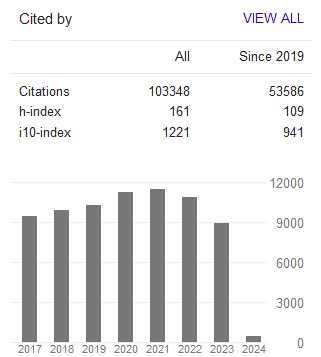The Effectiveness of Applying the Baldrige Quality Standards in Higher Education to Achieve Competitive Advantage: Case Study on Jordanian Private Universities
- Khawaldeh Faleh Obeidallah
Abstract
The aim of this study is to know the effect of applying the Baldrige quality standards in Jordanian private universities, to ensure that there is independence between them and to determine whether there is a statistically significant relation between the quality and competitive advantage strategies in the study community. The study population consists of (N = 685) staff members distributed in (6) private universities. A stratified-proportional-random sample (n = 220) represented by employees in universities departments, by representing (32%) of total population was selected in order to complete the research questionnaire, and 160 questionnaire representing (73%) of the study sample were retrieved. Data were analyzed using descriptive statistical techniques (frequencies, mean, and standard deviation) and inferential statistics (Correlation) and T test.
In addition to, the finding of this study indicate following:
1. There is an application by the Jordanian universities for the following quality standards for the following quality: the commitment of the senior management to the quality, the availability and analysis of the information, and the efficiency of the workforce, while both strategic planning and customer satisfaction were not applied.
2. There is reliability between strategic planning, customer satisfaction, workforce efficiency and competitive advantage strategies.
3. There is statistically significant relationship between the commitment of senior management to quality, strategic planning, and efficiency of the workforce with competitive advantage strategies.
4. There is significant effect on each of the Baldrige standards of independent quality, which includes the commitment of senior management to quality, customer satisfaction, information availability and data analysis on competitive advantage.- Full Text:
 PDF
PDF
- DOI:10.5539/ijbm.v12n11p218
Journal Metrics
Google-based Impact Factor (2023): 0.86
h-index(2023): 152
i10-index(2023): 1168

Index
- Academic Journals Database
- AIDEA list (Italian Academy of Business Administration)
- ANVUR (Italian National Agency for the Evaluation of Universities and Research Institutes)
- Berkeley Library
- CNKI Scholar
- COPAC
- EBSCOhost
- Electronic Journals Library
- Elektronische Zeitschriftenbibliothek (EZB)
- EuroPub Database
- Excellence in Research for Australia (ERA)
- Genamics JournalSeek
- GETIT@YALE (Yale University Library)
- IBZ Online
- JournalTOCs
- Library and Archives Canada
- LOCKSS
- MIAR
- National Library of Australia
- Norwegian Centre for Research Data (NSD)
- PKP Open Archives Harvester
- Publons
- Qualis/CAPES
- RePEc
- ROAD
- Scilit
- SHERPA/RoMEO
- Standard Periodical Directory
- Universe Digital Library
- UoS Library
- WorldCat
- ZBW-German National Library of Economics
Contact
- Stephen LeeEditorial Assistant
- ijbm@ccsenet.org
